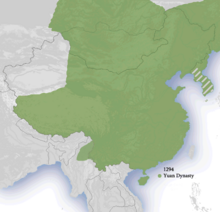
Back غوريو تحت حكم المغول Arabic Corée sous les Yuan French Korea di bawah kekuasaan Yuan ID 원 간섭기 고려 Korean Mongolijos Gorijo LT گوریو منگول حکمرانی کے تحت UR Cao Ly thuộc Mông Cổ VI
| Goryeo under Mongol rule Branch Secretariat for Eastern Campaigns 征東等處行中書省 정동등처행중서성 | |||||||||
|---|---|---|---|---|---|---|---|---|---|
| Vassal of the Mongol Empire and the Yuan dynasty | |||||||||
| 1270–1356 | |||||||||
 The client state Goryeo in modern Korea within the Yuan Dynasty, circa 1294. | |||||||||
| Capital | Gaegyeong | ||||||||
| Government | |||||||||
| • Type | Monarchy, client kingdom, branch secretariat, province | ||||||||
| Emperor | |||||||||
• 1270–1294 | Shizu | ||||||||
• 1294–1307 | Chengzong | ||||||||
• 1311–1320 | Renzong | ||||||||
• 1333–1356 | Huizong | ||||||||
| King | |||||||||
• 1270–1274 | Wonjong | ||||||||
• 1274–1308 | Chungnyeol | ||||||||
• 1308–1313 | Chungseon | ||||||||
• 1313–1330; 1332–1339 | Chungsuk | ||||||||
• 1330–1332; 1339–1344 | Chunghye | ||||||||
• 1351–1356 | Gongmin | ||||||||
| History | |||||||||
| 1231–1259 | |||||||||
• Established | 1270 | ||||||||
| 1274, 1281 | |||||||||
• Disestablished | 1356 | ||||||||
| |||||||||
| Today part of | North Korea South Korea | ||||||||
Goryeo under Mongol rule refers to the rule of the Mongol Empire and the Mongol-led Yuan dynasty over the Korean Peninsula from about 1270 to 1356.[1] After the Mongol invasions of Korea and the capitulation of the Korean Goryeo dynasty in the 13th century, Goryeo became a semi-autonomous vassal state and compulsory ally of the Yuan dynasty for about 80 years. It has been referred to as a "son-in-law kingdom in the Mongol Empire." The ruling line of Goryeo, the House of Wang, was permitted to rule Korea as a vassal of the Yuan, which established the Branch Secretariat for Eastern Campaigns (征東行省; literally "Branch Secretariat for Conquering the East") in Korea as an extension of Mongol supervision and political power. Members of the Goryeo royal family were taken to Khanbaliq, and typically married to spouses from the Yuan imperial clan, the House of Borjigin. As a result, princes who became monarchs of Goryeo during this period were effectively imperial sons in-law (khuregen). Yuan overlordship ended in the 1350s when the Yuan dynasty itself started to crumble and King Gongmin of Goryeo began to push the Yuan garrisons back.
- ^ "A History of Korea: From Antiquity to the Present, by Michael J. Seth", p112